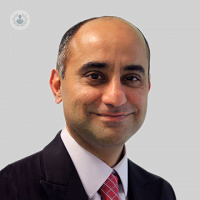5 incision techniques for breast augmentation
Escrito por:Breast augmentation is one of the most frequently performed cosmetic surgical procedures. Every year in the UK, thousands of silicone implants are used to enhance the volume and shape of a woman’s breasts and help many women feel more confident in their bodies.
Surgeons typically choose one of five ways to insert implants, and each will provide slightly different results depending on the patient’s anatomy and desired outcome.
Mr Haresh Devalia, a leading plastic, oncoplastic, reconstructive and aesthetic breast surgeon explains what these are.
What are the five incision techniques of breast augmentation?
There are five standard incision techniques used in breast augmentation in order to insert breast implants:
- Infra-mammary: A small incision is made in the fold under the breast. This technique allows the surgeon a wider access point with great precision.
- Peri-areola (around the nipple): The cut is made around the areola (nipple) edge and the scar is somewhat hidden, due to the pigmentation division of the nipple and breast skin. Surgeons tend to use this technique if they want to perform an additional but small breast lift.
- Trans-axillary: The cut is made in the armpit and the breast implant is inserted through this access point. A camera and special instruments will be needed to allow better positioning and placement.
- Trans-umbilical: The incision is made just above the belly button and the implants are then guided up to the breast from his point.
- Wise-pattern incision: This fifth technique uses an anchor-shaped incision. During this procedure, the surgeon makes an incision around the nipple, vertically down from the nipple to the breast fold and then horizontally along the fold, leaving a cut in the shape of an anchor. This is often the technique of choice when the patient requests a breast lift along with augmentation.
Which technique leaves a less visible scar?
Out of the three incisions that are made on the actual breasts themselves (infra-mammary, peri-areola, and anchor) the infra-mammary approach will leave a less visible scar.
The trans-axillary and trans-umbilical techniques won’t leave scars on the breasts - as the incisions are made elsewhere on the body - but will leave a scar either under the armpit or above the belly button.
The technique that leaves the more visible scar is the anchor incision - however, it does allow a considerable breast lift.
Are healing times different for each technique?
Most of them heal roughly at a similar rate, but the anchor one might take slightly longer. This is because significant lax skin is reduced to allow a breast lift, which in turn can then take longer to heal.
Most of the patients should feel well within 24 hours but will take between seven to ten days to get back to normal day-to-day activities. Internal healing of the breasts usually takes between three to six weeks.
What types of implants are available?
In regards to the texture of the silicone implants, they can be either smooth or textured. Textured implants develop scar tissue around them, making it more difficult for the implant to move inside of the breast and are filled with a thicker silicone. Smooth implants, however, will feel softer to touch.
The implants can either be round or teardrop-shaped. Teardrop implants will give the patient a more natural and sloped shape, whereas round implants provide a fuller look with added cleavage.
Most of my patients go for teardrop implants as they would like to look as natural as they can. I have noticed that patients around the age of 20 to 30 years old tend to opt for the round implants, and those in their 40s prefer just a slight boost and a more natural look that teardrop implants provide.
Where are the implants placed?
One of the most important factors in breast augmentation is the proper placement of the implants within the breasts. The implants can either be placed sub-glandular (behind the breast) or sub-muscular (behind the muscle). However, there is a technique that combines both of these: the dual plane implant placement.
I like to use the dual plane technique (Dr John Tebbett’s technique). During this procedure, the implants are placed under the chest wall, in the upper part of the breast, however, the lower parts of the implants are covered by the patient’s own breast tissue. This technique combines the previous two placements and therefore has the advantages of both. It also provides optimal implant placement for each individual, and these subtle adaptions can make a huge difference in the final aesthetic outcome.
Years ago, very few surgeons were able to carry out this procedure, however, this is now becoming more widely practiced. I do provide all the options to my patients, but overall, it is my preferred placement technique. In my opinion, it offers better long-term results with fewer complications.
If you are interested in a breast augmentation procedure, visit Mr Haresh Devalia’s Top Doctors profile and book a consultation with him.



